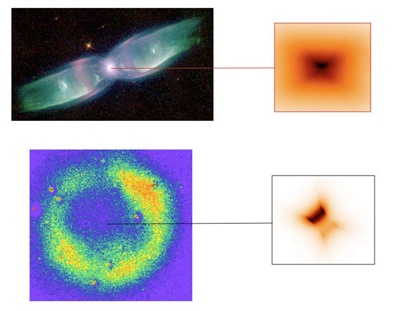
Dusty discs around stars young and old
DR EMILY BALDWIN
ASTRONOMY NOW
Posted: 15 April


Details of compact discs of rocky and dusty material have been detected around two young stars at similar distances as the Earth resides from our Sun, and around two ageing stars, providing information on discs at various stages of their evolution.
Dr Rachel Smith of Keele University presented results obtained using the MIDI interferometer at ESO’s Very Large Telescope in Chile, at this week’s National Astronomy Meeting in Glasgow. MIDI combines the infrared light from the four 8-metre VLT telescopes, creating the performance capabilities equivalent to a 100 metre diameter telescope.
The first star, HD69830, is a two billion year old orange star located 41 light years away towards the constellation Puppis and hosts three Neptune-mass planets. The second star, eta Corvi, is a 1.3 billion year old F2V class star.
HD69830’s disc lies between 7.5 and 360 million kilometres from the host star and would be a spectacular sight for anyone standing on the surface of one of its three planets. A similar disc lies between 24 and 450 million kilometres from eta Corvi. For context, the Earth orbits the Sun at a distance of 150 million kilometres.
As to the origin of these dusty rings, Smith suggests that impact debris from asteroids and comets colliding with planets, in the case of HD69830 at least, could be to blame. For eta Corvi, the material may have migrated in from an outer cooler disc that has been observed 22.5 billion kilometres from the star.
“With MIDI we have access to a truly giant telescope that can see the Universe in unprecedented detail,” says Smith. “By probing regions of a similar scale to the Earth’s orbit we have the potential to observe the dusty results of massive collisions in the final stages of rocky planet formation, and learn about the conditions Earth-like planets in other planetary systems may experience. The opportunities for directly testing our theories for how planets form and evolve have never been greater.”
 Top: Bipolar nebula M2-9 (image: B. Balick, HST) with a reconstructed image of its dusty disc observed by VLTI. Bottom: Round nebula around Sakurai's Object (image credit: A. Zijlstra, University of Manchester) with
its corresponding disc.
Top: Bipolar nebula M2-9 (image: B. Balick, HST) with a reconstructed image of its dusty disc observed by VLTI. Bottom: Round nebula around Sakurai's Object (image credit: A. Zijlstra, University of Manchester) with
its corresponding disc.
In another VLT study astronomers from the University of Manchester's Jodrell Bank Centre for Astrophysics and the Observatoire de la Cote d'Azur in France have probed the dusty discs around ageing stars. The study will teach astronomers more about what’s in store for our own Sun, which in five billion years time will swell up into a red giant star, its outer layers expanding to form a tenuous atmosphere of gas and dust.
The team studied the disc of M2-9, a bipolar nebula – a gas cloud with symmetrical lobes – that is concealing a red giant 2,500 times more luminous than the Sun, along with a white dwarf star. The red giant is producing the dust, creating a ring which has an inner radius of 2,250 million kilometres and an outer radius near 135 thousand million kilometres. It is composed of dust grains made out of silicon and oxygen, similar to the dust found in our Solar System.
"The disc inside M2-9 is probably less than 2,000 years old, making it a teenager in terms of the lifetime of these discs. It is still evolving due to the gravitational interactions of the binary stars," says Foteini Lykou. “We are not sure exactly how long these discs survive – it could be hundreds of thousands or possibly millions of years.”
A second disc was found in Sakurai’s Object, a 12,000 degree Celsius star 10,000 times brighter than the Sun, which is growing in size. "The disc in Sakurai’s Object was created within the last 10 years, so we have the opportunity to study a newborn disc. It is expanding radially – and rapidly – in space.” The team saw the disc extend from 10 thousand million kilometres to 75 thousand million kilometres during their study period in 2007.
The team suggest that in the future the discs may be destroyed by interstellar radiation breaking down the dust grains to their individual atoms and molecules, thus replenishing and enriching the Galaxy’s interstellar medium with new materials.
|



